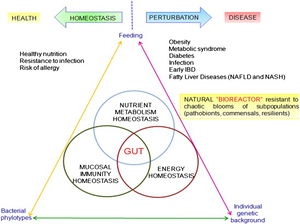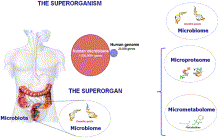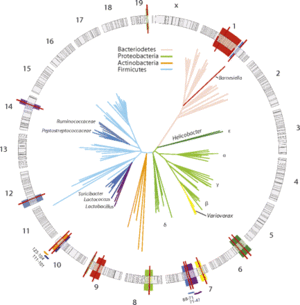Link Between Microbes and Obesity
Introduction

By [Student Name]
At right is a sample image insertion. It works for any image uploaded anywhere to MicrobeWiki. The insertion code consists of:
Double brackets: [[
Filename: PHIL_1181_lores.jpg
Thumbnail status: |thumb|
Pixel size: |300px|
Placement on page: |right|
Legend/credit: Electron micrograph of the Ebola Zaire virus. This was the first photo ever taken of the virus, on 10/13/1976. By Dr. F.A. Murphy, now at U.C. Davis, then at the CDC.
Closed double brackets: ]]
Other examples:
Bold
Italic
Subscript: H2O
Superscript: Fe3+
Introduce the topic of your paper. What microorganisms are of interest? Habitat? Applications for medicine and/or environment?
Gut Microbiota

The role of the gut microbiome is the focus of renewed interest in health and disease. There has been an increasing number of publications related to the intestinal microbiota each year in the last two decades. Most studies were devoted to understanding the impact in the intestinal environment, however, new studies are looking at the effect of commensal microbes on the mammalian gut. The human gut microbiota consists of microorganisms that live in the digestive tract and is considered the largest reservoir of the human flora. The composition of the human gut microbial community is host specific. The microbial community is continually evolving due to exogenous and endogenous modifications. The microbiota can be at the center of causing many diseases which can have serious effects on both near and far organ systems. The balance in the composition of the gut microbial community is an important indicator of maintaining homeostasis or not.
The human body is inhabited by a vast number of bacteria, archaea, viruses, and unicellular eukaryotes. The microbiota refers to the group of microorganisms living in peaceful coexistence within their host. It is estimated that the human microbiota contains as many as 10¹⁴ bacterial cells. The human gut, a very large organ, has the surface size of approximately 200 m². Therefore, the human gut is an important surface for microbial colonization, along with GIT which is rich in microbial nutrients.
The gut microbiota is mostly composed of strict anaerobes; 99% of the bacteria in the gut are anaerobes. The human gut microbiota is dominated by two bacterial phyla: Bacteroidetes and Firmicutes. The following bacterial phyla: proteobacteria, verrucomicrobia, actinobacteria, fusobacteria, and cyanobacteria also have a smaller presence in the gut microbiota. The human gut microbiota can contain approximately 500 to 1,000 species and the collective human gut microbiota is composed of over 35,000 bacterial species. The intestinal microbiota is not homogeneous; the number of bacterial cells present in the mammalian gut increases as it moves through the GI tract. 10¹ to 10³ bacteria per gram are present in the stomach and duodenum. The number of bacteria per gram increases to 10¹² in the colon, which is the final location of the GI tract. Different bacterial groups thrive at each different site in the intestine. For example, Bacteroides are found in feces whereas only Clostridium, Lactobacillus, and Enterococcus were found in the mucus layer of the small intestine. The presence of colonized microbes in the human gut begins immediately at birth. During first year of life, the gut microbiota varies from human to human. However, after one year of age, the gut microbiota stabilizes and colonizes. Human gut-microbe populations fall into three distinct categories. The three categories are named after the dominant genus: Bacteroides, Prevotella, and Ruminococcus. Bacteroides are known for being able to break down carbohydrates. Prebotella are known for degrading the slimy mucus in the gut and will therefore lead to increased gut pain. Ruminococcus help cells to absorb sugars which can be associated with weight gain. This revelation can help identify the causes of obesity and inflammatory bowel disease. The identification of a person’s gut type makes it possible for a person to determine what they can eat to stay slim and how well they metabolize. There are many contributing factors to the composition of the gut microbiota. Gut microbial composition can depend on host genetics, mutations, and diet.
Obesity

I Obesity is the leading preventable cause of death worldwide. Obesity is a medical condition that affects 35.9% of the American population 20 years and older. Excess body fat accumulates and leads to adverse effects on health which can lead to a reduced life expectancy and increase health problems. An person is considered obese when their BMI, body mass index, exceeds 30 kg/m². Body mass index is determined by dividing a person’s weight in kilograms by the person’s height squared. Obesity increases the likelihood of the following diseases: heart disease, type 2 diabetes, obstructive sleep apnea, and osteoarthritis. Obesity occurs when a person consumes more calories than he or she burns. Therefore, the most common cause is a person eating too much and exercising too little. Other factors that play a role in obesity are: age, gender, genetics, environmental factors, physical activity, psychological factors, illness, and medication. Treatment options for obesity include dieting and physical exercise. It is important to understand the mechanisms behind obesity and look to the correlation between the gut microbiota and obesity.
Section 3
Include some current research, with at least one figure showing data.
Conclusion
Overall text length at least 3,000 words, with at least 3 figures.
References
Edited by student of Joan Slonczewski for BIOL 238 Microbiology, 2011, Kenyon College.
